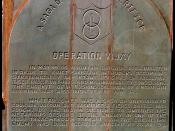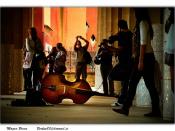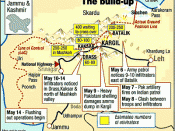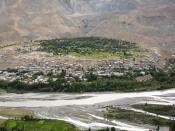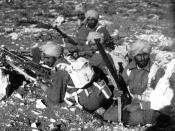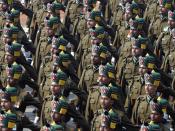SADBHAWANA "" A SOCIO POLITICAL IDEOLOGY AS CONFLICT PREVENTION STRATEGY The World We Inhabit This is a varied world in which we live. There is a wide disparity between various groups "" in terms of economic power, military power, influence in political activities, social status etc. This necessarily leads to struggle by the oppressed or not so recognised groups to gain more of whatever they lack, or so they perceive. This struggle is directed by such groups against the most dominant or most powerful group. Such struggle gives rise to conflicts wherein the dominant groups label the others as irrational and misguided who are out to endanger world peace and order. As conflicts grow in dimension and impact, they may pose a threat to the very continuity of civilisation and hence need to be checked early "" best if nipped in bud itself, not allowed to germinate at all. For this the only conflict strategy that can give total prevention against such conflicts is "Sadbhawana" or "Goodwill".
Conflicts, as they become prevalent, are also becoming a fact of life in most parts of the world. Access to sophisticated weapons and technology has lent conflicts a bloody turn wherein various groups continue to surprise their opponents. In order to establish some degree of order in the communities, it is imperative for the world to realise that conflicts are best prevented rather than resolved or neglected. For prevention of conflicts, understanding of what causes conflicts is necessary. Usually, after any conflict, the general tendency is to retaliate by counter-action, sanctions of various types trying to put the erring group in a disadvantageous position. But, this approach relegates the "middle ground", the innocent people suffering in the bargain, to the background.
Why Are We Fighting What motivates people to suspend their sense of morality and engage in conflicts is simply frustration, triggered by the difficulty in achieving the desired ends through existing political and legal channels. Within the areas of frustration in the world today, such conflicts flourish with a vengeance.
High on the list of frustrations that lead to conflicts in society (or world at large) is nationalism, a motivation that has been difficult to counter. If a minority within a state feels that its identity is being threatened or that it is not gaining the political recognition it deserves, often it will resort to violence. This is both to attract attention to its cause and to try to force the government to grant concessions. Groups such as the Kurds or the Basques have realised that the present line up of states is unlikely to satisfy their aspirations, so they turned to violent conflicts in an effort to force the issue.
Political ideology is another reason for world conflicts. It also permits no compromise on part of its adherents and encourages them to be ruthless. If a group believes that its ideals in pursuit of a utopian society are the only ones to be followed, its members will readily either die themselves or kill others for the cause. Such beliefs draw entire nations into conflicts in which no holds are barred. The clashes in the twentieth century between democracy and fascism, fascism and communism, and democracy and communism have all produced bloody conflicts. In all the cases, it is those people occupying the middle ground who are targeted and whose fears are exploited for political ends. Extreme ideas thrive among desperate, dispossessed and disenchanted people and there are plenty of such people around in the world.
In liberal democracies, the frustration that leads to conflicts may arise when ideologically committed groups "" invariably a minority of the population "" cannot get their voices heard through the legitimate political electoral process. If the aims of such a group appear to be at odds with the social and political norms of the state, the group may be deliberately blocked from all means of publicising its cause and exerting legitimate pressure, leaving its members unable to see how they can get their message across without recourse to violence. Groups such as West Germany's BaaderMeinhof Gang certainly followed this path in the late 1960s and early 1970s. They came to believe that the only way to change the society so that it reflected their often Utopian ideals was to destroy the existing political and legal establishments, thus opening the way to much needed reforms.
Closely related to ideology is religion. It deals with human souls rather than territory or class structures, but it has an added ingredient in that true believers are often more than willing to sacrifice their own lives in obedience of their particular God. Muslim fundamentalism based on Koran's laws, appeals to many throughout the world, who see it as their duty to ensure that others share their ideals or perish if they do not. Similarly, the Hindu fundamentalists are ready to sacrifice innumerable lives to have a concrete structure built in a particular place. Such groups try to demonstrate how feeble even the most powerful state is at protecting its own people, who start to fear that to oppose fundamentalism is to court disaster. So long as people have beliefs that close their minds to the possibility of alternatives, violent conflicts will persist.
International politics has also played an important role in perpetrating conflicts at large scales. The old adage that "my enemy's enemy is my friend" applies to relations between recognised states and terrorist groups as it does between recognised states themselves, ensuring that even the smallest of subversive organisation/group can gain much-needed support. It is not only the enemies of the West who provide support to such groups in multifarious ways including financial and logistic support. For example, US supported the Contras in Central America in the 1980s, to counter what it perceived as the spread of communism into Nicaragua. Pakistan has supported any subversive group that attacks India.
Can We Do Something To Stop It Once the world is aware of various conflict generating factors, the natural next step, in the form of action, becomes trying to prevent any conflict before it even germinates or, in later stages, assumes an unmanageable stature. One of the ways out is harmony, positive coordination, synergic relationships among various sub-groups forming a part of the overall social and political structure. Empowerment of the weakest link in the social fabric and ensuring their participation in the overall socio-econo-political setup and empathy goes a long way in ensuring that the entire group is cohesive and no external force can entice away any part of it.
Indian Initiative : This is exactly what the XIV Corps of Indian Army (the only high altitude Corps in the world) has proved in its ingenious effort of OPERATION SADBHAWANA to carve out a place of its own in the hearts of the people of border villages near the LoC in J&K. Indian Army has taken on the task of winning over hearts and minds after winning the battle in Kargil. Their objective : The People - implant a feeling of Indianness in their hearts and to integrate them with the mainstream. Indian Army is out to make peace with the same zest with which it made war in the hills around Kargil. It has adopted a humane approach which is people centred, rather than people targeting. In Op Sadbhawana, Indian Army is trying to win over hearts of people especially along the LoC and militancy prone areas. This has been identified as the single most important factor in this sector. Earlier, despite distributing rations regularly to gain goodwill , the villagers were actively involved in arms smuggling across the LoC into India and they also connived with Pakistan in the Kargil war. This sector assumes added importance owing to the heights that surround it. If any of the heights is lost, Indian Army's road link to Siachen base camp which launches all the supplies, will be snapped. Plus, it will also expose the crucial Central Glacier to Pakistan gun fire crippling Indian positions all over Siachen.
Indian Army has adopted three Lakh persons from Turtuk, Partapur, Biagdang, Skampuk, and Tyakshi for Rs 35-Crore "Operation Sadbhawana" programme that gives thrust to primary education, secondary and tertiary health care community development and empowerment of women. Army has opened 16 Sadbhawana schools with libraries, computers, and video-audio education facilities, first aid centres and mid day meal schemes for students. The border area is thus live with development activities. It has opened Umeed Resource Centre in Kargil where 400 children are treated, trained and rehabilitated. Besides giving the children nutrition and specialised treatment, the centre also keeps computerised records of their health as inbreeding and Iodine deficiency have resulted in almost 10 percent of the population being handicapped. Apart from medical and school facilities, there is a vocational training centre for women which a lot of computers, carpet weaving looms and sewing machines.
The Operation Sadbhawana has had such impact that in Kharbu, that people kept on urging the Corps Commander to ensure that Army, and not the local administration gets the Planning Commission's allocation for a solar heating and lighting programme. Also, the two rival Shia organisations have offered their buildings to Army for use in social service and are, in addition, active in mobilising the people. The efforts to win over people has taken army beyond Operation Sadbhawana, when people of Zaskar and Suru Valley informed the authorities about their suspicion of the Bakerwals (Cattle grazing nomads) acting as guides to Pakistan ISI. This was a great shift in their behaviour which had always been pro-Pakistan till now. The locals had always felt more Pakistani. Pakistan television and radio were the electronic media seen and heard here. Doordarshan and All India Radio had not been able to match this and were barely seen or heard there. Thus, the information regarding suspected Pakistani-informers depict a major shift in their attitude towards India and Indian Army.
It is such measures of Sadbhawana or Goodwill that are going to win over people and pull them away from subversive activities. A goodwill mission with humane approach, acts on multiple fronts "" it helps individual to meet his basic needs in life by institutional support, provides much needed educational input to the children where people had never seen a school. This forms bonds of love with population and slowly, they have a heart change. Here Army departed from the explicit role of entering the scene when the physical conflict had commenced. Instead, it is preventing conflict "" "If we can be part of UN peace keeping force, why can't we keep peace in Indian." (Lt Gen Arjun Ray, Commanding Officer XIV Corps) Army has shown that the best antidote to infiltration is border development.
Thus, to prevent conflicts in a society, administration can use : (a) Prophylaxis or Sadbhawana ; (b) Police action as their strategies and (c) Denial of the objectives to the trouble makers.
Prophylaxis or Sadbhawana : It is a widely accepted fact that it may not be possible to totally eliminate the conditions in which conflicts arise in societies except the road to totalitarianism. However, the regime must take and also seem to take steps to remove such conditions. For winning public confidence the regime must be consistently undertaking reforms effectively. The conflict-arousing elements must be denied public support by : (ii) not over reacting and alienating people at the same time affording adequate protection (iii) providing counter attraction through political social and economic reforms.
Conflict is a subjective phenomenon that generates terror in general public and hence must be countered in the minds of men. Enlightened and cooperative public is the best counter-violence and conflict force for the regime. Because incomprehensiveness and a sense of helplessness are two major factors which cause crossing of threshold of violent conflict efforts to make public comprehend the threat and mobilising public by giving them something to do will go a long way in reducing terrifying impact of conflicts. Educating people about recognising weapons, what to do in various violent situations will not only make public more security conscious but will make them actively partake in anti violent activities. This will reduce the sense of helplessness.
Police Action : The police action will consist of three major parts : (i) Intelligence and counter intelligence (ii) Protective function (iii) Strike against identified trouble makers.
The importance of intelligence and counter-intelligence can not be over-emphasized. Even when the public is won over, the handful remnants can be located only through intelligence. It would be very difficult to gather intelligence about a trouble making group from the scratch; hence infiltration of likely groups may take place in the initial stages.
In providing protection to VIPs and vital installations, care must be taken to cause minimum inconvenience to general public. Moreover, adequate protection must be provided to the public. In policing, if the police appear to be manned and controlled by a distinct ethnic or religious group, public may loose confidence and cooperation of other sections in a conflict situation.
Denial of the objectives to the trouble makers : This has to be planned carefully. In case of publicity, too much restriction can lead to rumours whereas too little will facilitate the subversive elements. It would be worthwhile enlisting support of the media to combat conflict generating situations. Similarly, any reaction to violent activity already occured has to steer between which would alienate people and too little when people feel abandoned. Here is the need to enlist their support by educating them and it would be of huge benefits.
Finally, constant research and analysis into the subversionists' methodology, organisation and activity is the only way to avoid panic reaction when crisis situation arises. It is easier to expand infrastructure for combating terrorism already in existence than creating it ab initio. Peace, like liberty must be won again and again and constant vigil is the price.
The "Individual" Factor Ultimately, all subversive activities in any conflict situation are committed by individuals who feel that their aims are so important that they will use any means to achieve them. Few, if any, will achieve what they desire, but they will continue to try, if only for the thrill of using violence and attracting publicity. Government agencies and security forces, which are now more accustomed to dealing with problem will be able to score successes, but care will always have to be taken to avoid militarisation and repression. Instead, the role of security forces must now include Conflict Prevention, as has been adopted by Indian Army wherein it has taken upon itself the Sadbhawana ideology for its border management through community development and participation. The best antidote to infiltration, subversive activities and conflicts is people participation and development. One can not have secure environ if there exist human insecurities. Also, if it can work in Kashmir Valley, it can be replicated anywhere in the world hot spots. There is no purely armed solution to conflicts in the society. We've got to concentrate on people. Only rider being : It is a delicate balance, the fulcrum of which is always the ordinary citizen "" grant them quality life, right to exercise options and enough opportunities and thereafter, the rest should be left to history and people, they'll never fail us.
